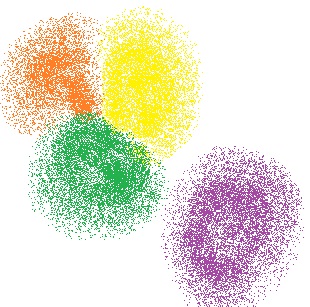node-kmeans
Node.js asynchronous implementation of the clustering algorithm k-means
Installation
$ npm install node-kmeans
Example
// Data source: LinkedIn
const data = [
{'company': 'Microsoft' , 'size': 91259, 'revenue': 60420},
{'company': 'IBM' , 'size': 400000, 'revenue': 98787},
{'company': 'Skype' , 'size': 700, 'revenue': 716},
{'company': 'SAP' , 'size': 48000, 'revenue': 11567},
{'company': 'Yahoo!' , 'size': 14000 , 'revenue': 6426 },
{'company': 'eBay' , 'size': 15000, 'revenue': 8700},
];
// Create the data 2D-array (vectors) describing the data
let vectors = new Array();
for (let i = 0 ; i < data.length ; i++) {
vectors[i] = [ data[i]['size'] , data[i]['revenue']];
}
const kmeans = require('node-kmeans');
kmeans.clusterize(vectors, {k: 4}, (err,res) => {
if (err) console.error(err);
else console.log('%o',res);
});Inputs
- vectors is a nXm array (n [lines] : number of points, m [columns] : number of dimensions)
-
options object:
- k : number of clusters
-
distance (optional) : custom distance function returning the distance between two points
(a,b) => number, default Euclidian Distance
- callback node-style callback taking error and result argument
Outputs
An array of objects (one for each cluster) with the following properties:
- centroid : array of X elements (X = number of dimensions)
- cluster : array of X elements containing the vectors of the input data
- clusterInd : array of X integers which are the indexes of the input data
To do
- Technique to avoid local optima (mutation, ...)
Author
Philmod <philippe.modard@gmail.com>
